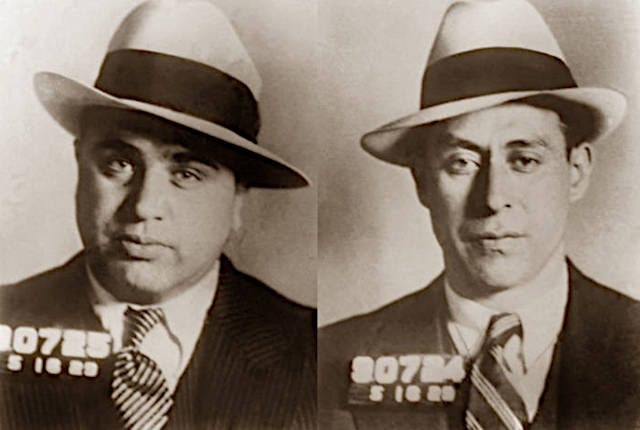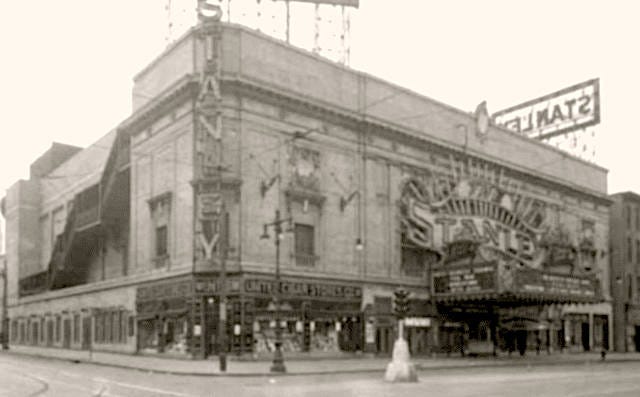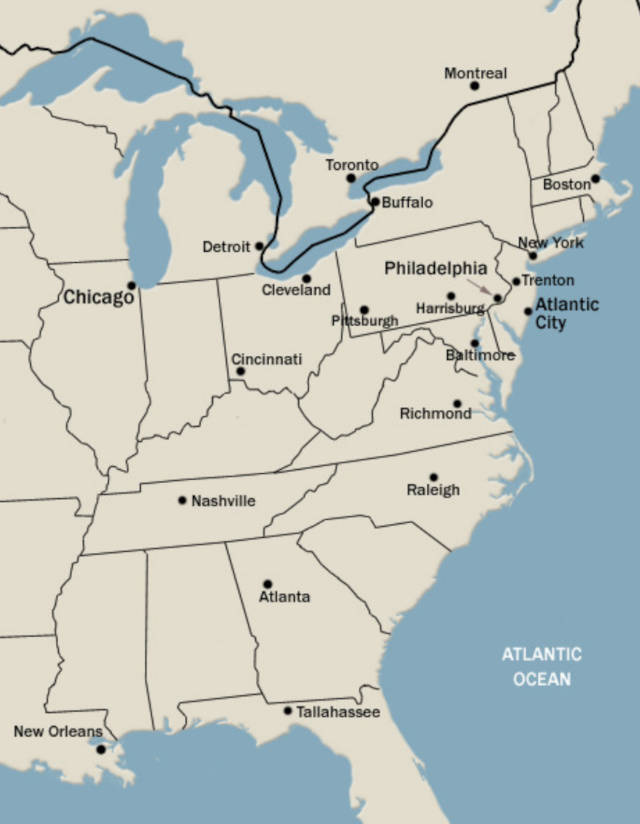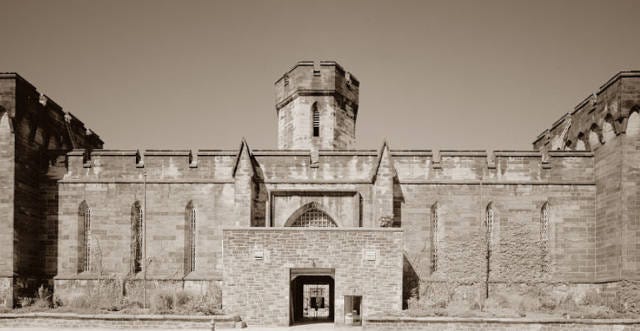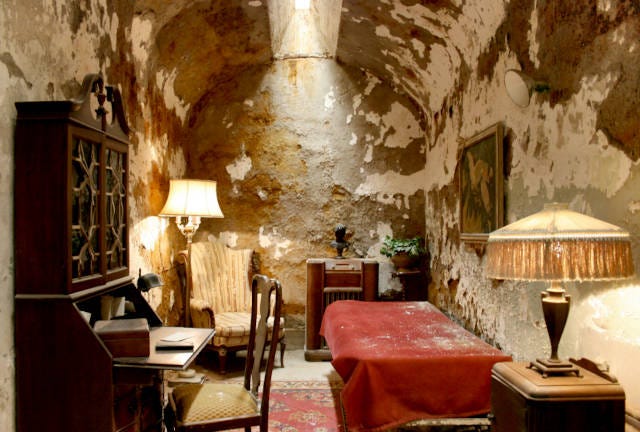Capone never sought Philly prison
The many conspiracy theories about spring 1929 don't hold water
Following spring 1929 underworld meetings at Atlantic City, New Jersey, Chicago underworld boss Al Capone and his aide Frank Rio took the long way home - a very long way home. Their ten-month detour through Pennsylvania prisons sparked a number of conspiracy theories, none of which really hold water.
Capone and Rio left Atlantic City in an automobile on May 16, 1929, heading to a train station in North Philadelphia, where they intended to board the Broad Way Limited (the Pennsylvania Railroad's premier train, which catered to first-class passengers) to Chicago that afternoon. But, outside Philadelphia, their car broke down, and they reached the city too late for their train. They made reservations on the less prestigious Manhattan Limited, which was to depart toward Chicago that evening. With some time on their hands, they went to see a movie at the Stanley Theatre at Nineteenth and Market streets.
When they came out of the theater, they were confronted by two Philadelphia police detectives. One of the detectives - James Malone - was acquainted with Capone and spotted him going into the Stanley. Questioned, Capone admitted that he and Rio were in possession of handguns. They turned their weapons over to the detectives and were placed under arrest on a charge of carrying concealed deadly weapons. They were processed and held in the city hall lockup.
That night, Capone had a long and apparently quite frank conversation with Philadelphia's Director of Public Safety Lemuel Schofield, admitting that he was going back to Chicago after a gangland peace conference in Atlantic City. (Additional indefensible legends arose about the conference itself, but we'll have to get to those another time.) At the end of their discussion, Schofield assured Capone that he would get “a square deal” at a hearing on the weapons charge.
It's worth noting that the term “square deal” may have been interpreted very differently by the professional racketeer than it was intended by the law enforcement official.
Capone and Rio were brought before Police Magistrate Edward Carney just after midnight on May 17. The magistrate ordered them held overnight and set bail at $35,000. Defense counsel Bernard J. Lemisch asked for a more reasonable bail amount (Capone reportedly couldn't immediately arrange more than $10,000), but Carney was clearly determined that the prisoners remain prisoners until morning. According to sources, Capone made a dismissive comment about the charge against him but noted of the Philadelphia justice system, “They work fast here.”
‘They work fast here’
That turned out to be very true. By ten-thirty in the morning of May 17, Capone and Rio had been served breakfast, had appeared in a police detective lineup and had been indicted by a grand jury. After one more hour, a jury was in place, not-guilty pleas were entered for the defendants, and Assistant District Attorney Charles Kelley was ready to open his case in the courtroom of Judge John Walsh.
Lemisch and co-counsel Cornelius Haggarty Jr. succeeded in winning just a half-hour recess to confer with their high-profile clients. After that, they failed horribly in their efforts to arrange plea deals. Capone offered to post a large bond guaranteeing he would never again enter Pennsylvania if he was discharged. He then offered to plead guilty and post a similar bond if given a suspended sentence. He even offered to accept a three-month prison sentence and to pay a bond to steer clear of the state in the future. None of the proposals were acceptable to the court.
Lemisch and Haggarty then requested a two-day postponement of the trial, so they could prepare a defense. The judge said no.
As the trial commenced just after midday, Capone and Rio changed their pleas to guilty. Their reasons for doing so were not explained, but their pleas probably did not change the outcome of the case. The defendants were, in fact, guilty of the charges against them. And the court was clearly uninterested in showing any leniency. All efforts toward compromise or delay had been defeated. Possibly, Capone and Rio imagined the judge would be satisfied with notching a guilty verdict against the famous mobsters and suspend sentence or allow them their freedom during a legal appeal.
Instead, Judge Walsh immediately sentenced both men to a year in prison. Capone and Rio were on their way to Moyamensing Prison in South Philadelphia before one o'clock in the afternoon. They spent one night at Moyamensing, and they were transferred to Philadelphia County Prison in the northeastern Holmesburg neighborhood the next afternoon.
Conspiracy theories
Members of the press wasted no time in developing conspiracy theories to accommodate the sudden imprisonment of Capone in Pennsylvania. The Chicago Tribune of May 18 suggested that Capone wanted to go to prison in Pennsylvania. It said that Capone's acquaintance with Detective Malone was evidence of a conspiracy. The newspaper further stated, quite incorrectly, that Capone made no effort to free himself of the charges or even to delay his trial. According to the Tribune, Capone had agreed to have himself locked up as part of the peace plan arranged with Chicago rivals in Atlantic City.
The Washington Post suggested that Capone's guilty plea was evidence of his desire to be imprisoned. He would have brought in outside lawyers to get him released on bail if he had not been determined to be locked up, the newspaper argued, ignoring the fact that delays and bail releases were blocked by the court. The Post suggested that Capone's imprisonment was to be an alibi during the planned murder of Chicago rival George Moran. But, of course, Moran was not murdered. (He died in a federal prison hospital years later.)
Other sources claimed that Capone was seeking safety in Philadelphia prisons from underworld rivals, failing to notice that the region was then home to a conservative Mafia faction not particularly friendly with Capone. (The Philly Mob would soon fight against the Giuseppe Masseria-Al Capone combination during the 1930-31 Castellammarese War).
As time passed, more and more conspiracy theories were offered. In his 1970 biography of Capone's former boss and mentor Johnny Torrio, author Jack McPhaul decided that Torrio was in fact behind the plot to have Capone cool off behind bars. According to McPhaul, who provided nothing in the way of source citations, Torrio personally presided over the Atlantic City conference and arranged the Philadelphia arrest to allow the press and public to forget recent Capone-orchestrated violence in Chicago - the St. Valentine's Day Massacre and the murders of Anselmi, Scalise and Giunta.
All the conspiracy theories assert that Al Capone either personally wished to stay in prison or at least accepted that he needed to be in prison. We can test the theories by seeing if Capone's actions match these alleged motivations.
Unhappy prisoner
Al Capone certainly did not behave as if he wanted to be in prison or accepted that he needed to be there. He fought hard to be released, investing substantial sums in legal appeals. Early in his prison term, he hired Pennsylvania Congressman Benjamin M. Golder to work with Lemisch on appeals. And Public Safety Director Schofield told the press that he heard the Chicago crime boss was offering $50,000 (nearly $1 million in today’s dollars) to any lawyer who could help get him released before the expiration of his full sentence.
Capone and his attorneys aggressively appealed the prison sentence. On June 26, 1929, Golder filed a writ of error appeal to Judge Walsh, charging that the judge “predetermined [Capone's] guilt and had stated he would help convict the defendant.” In the appeal, Golder stated that Capone was denied adequate time to prepare his defense, that he was prevented from issuing subpoenas for defense witnesses, that he was tried before a prejudiced jury in a courtroom filled with a prejudiced crowd and presided over by a prejudiced judge. According to Golder, Capone felt pressured to enter his plea of guilty. Golder asked that Walsh release Capone on bail while his appeals were processed. The judge refused.
Golder took the bail request to the Pennsylvania State Superior Court, where it was refused on July 1, 1929.
On August 8, Capone was again transferred. He was secretly moved from the county facility at Holmesburg to the fortress-like Eastern State Penitentiary on Fairmount Avenue near the center of Philadelphia. The move reportedly was made because some prisoners had made threats against Capone's life.
Capone's guilty plea was reportedly a major problem in his appeals. A legal analyst told the New York Times that Pennsylvania law differed from the law in Capone's home state of Illinois in that Pennsylvania provided for no appellate review of guilty pleas.
Efforts to win Capone's release were not restricted to legal appeals. District Attorney John Monaghan revealed on August 17 that he was approached with an offer of $50,000 to help Capone gain his freedom. The prosecutor said he turned down the offer.
Read and interact with our short-form content in Substack Notes.
Golder on September 21 brought Judge Walsh a petition, asking for parole to be granted to Capone. Walsh would not receive it. On October 4, the judge stated that he could not consider the matter because he no longer had jurisdiction over a Capone parole. Capone's transfer from the county facility to the state prison effectively took the matter out of his hands, he said.
Golder sought habeas corpus writs for Capone and Rio through State Superior Court. He was turned down. He then appealed to the Pennsylvania State Supreme Court in November, noting that the usual sentence for carrying a concealed deadly weapon was not a term of a year in prison but a term of six months to a year. A six-month sentence, he explained, would expire on November 17, 1929. The Supreme Court rejected that appeal on November 26.
Only at that point did Capone finally relent. He had already completed more than half of the one-year sentence. A full good-behavior allowance would allow for his release on March 17, 1930, after having served a total of ten months. It was noted that an additional appeal, even if successful, could not have freed him sooner than that.
Conclusion
Capone never gave any indication of a desire for or even an acceptance of his one-year prison sentence. His behavior before and after trial indicated that he wanted nothing more than to remain free and to return to his home in Chicago.
If getting himself incarcerated in Philadelphia was part of a predetermined plan, he need not have purchased train tickets, developed a car-breakdown tale, visited a movie theater, had a revealing conversation with the city public safety director, offered numerous plea deals and pursued many expensive legal appeals. That he did all of those things proves the conspiracy theories false.
This article was condensed from “Al Capone’s long stay in Philadelphia,” a feature article in the October 2010 issue of Informer: The History of American Crime and Law Enforcement.
Sources
“Al Capone denied freedom on writ,” Washington Post, June 30, 1929, p. M3.
“Al Capone given year; to hide in jail, is view,” Washington Post, May 18, 1929, p. 1.
“Al Capone starts new liberty fight,” Washington Post, Sept. 22, 1929, p. 3.
“Atlantic City calls Capone ‘undesirable,’” New York Times, May 16, 1929, p. 27.
“Bail denied Capone by Superior Court,” New York Times, July 2, 1929, p. 36.
“Bribe to free Capone alleged by official,” New York Times, Aug. 18, 1929, p. 26.
“Capone asks retrial; assails court action,” New York Times, June 27, 1929, p. 31
“Capone enters jail to serve one year,” New York Times, May 18, 1929, p. 1.
“Capone in jail garb loses good cheer,” New York Times, May 19, 1929, p. 24.
“Capone is shifted to another prison because fellow-inmates threatened him,” New York Times, Aug. 9, 1929, p. 1.
“Capone loses again,” New York Times, Nov. 27, 1929, p. 21.
“Capone makes jail,” Washington Post, May 18, 1929, p. 6
“Capone plea fails,” New York Times, Oct. 5, 1929, p. 21.
“Capone reported seeking freedom,” Washington Post, June 16, 1929, p. M2.
“Capone slips away from new prison, eluding throngs,” New York Times, March 18, 1930, p. 1.
“Capone takes cover in jail,” Chicago Daily Tribune, May 18, 1929, p. 1.
“Capone takes new appeal,” New York Times, Nov. 7, 1929, p. 13.
“Capone will go back to Chicago Monday,” Washington Post, March 15, 1930, p. 1.
“Capone’s freedom soon is predicted,” Washington Post, June 24, 1929, p. 1.
“Capone’s friends fail to act in Quaker City,” New York Times, May 21, 1929, p. 26.
“Court refuses Capone new trial,” New York Times, June 30, 1929, p. 19.
“Crime: Capone coup,” TIME, May 27, 1929.
“Fight for freedom is lost by Capone,” Washington Post, Nov. 27, 1929, p. 1.
“Gang to fight for freedom of Al Capone,” Washington Post, May 19, 1929, p. 1.
“Quaker City police arrest Al Capone,” Washington Post, May 17, 1929, p. 1.
“Scarface Al is moved to state penitentiary,” Washington Post, Aug. 9, 1929, p. 1.
“Supreme Court refuses bail writ for Al Capone,” Washington Post, July 2, 1929, p. 10.
“Third release plea made by Al Capone,” New York Times, Sept. 22, 1929, p. 22.
“Triple killing laid to feud in Sicilian gang,” Chicago Daily Tribune, May 9, 1929, p. 1.
“Will usher Capone out of Quaker City,” New York Times, March 16, 1930, p. 4.
Halper, Albert (editor), The Chicago Crime Book, Cleveland: World Publishing Company, 1967
Kobler, John, Capone: The Life and World of Al Capone, New York: G.P. Putnam’s Sons, 1971.
Lester, W.H.D., “Memorandum for the director,” Jan. 6, 1933, Al Capone FBI File.
McPhaul, Jack, Johnny Torrio: First of the Gang Lords, New Rochelle, NY: Arlington House, 1970.
Peterson, Virgil W., The Mob: 200 Years of Organized Crime in New York, Ottawa, IL: Green Hill Publishers, 1983.





